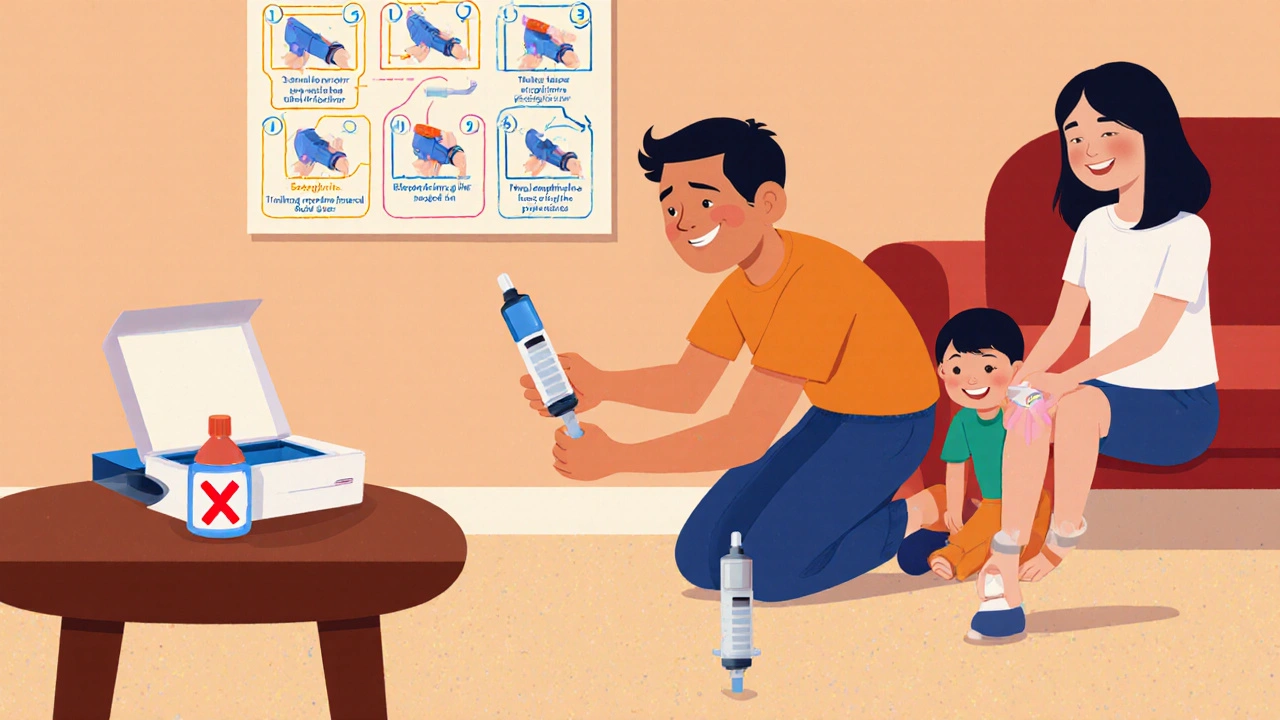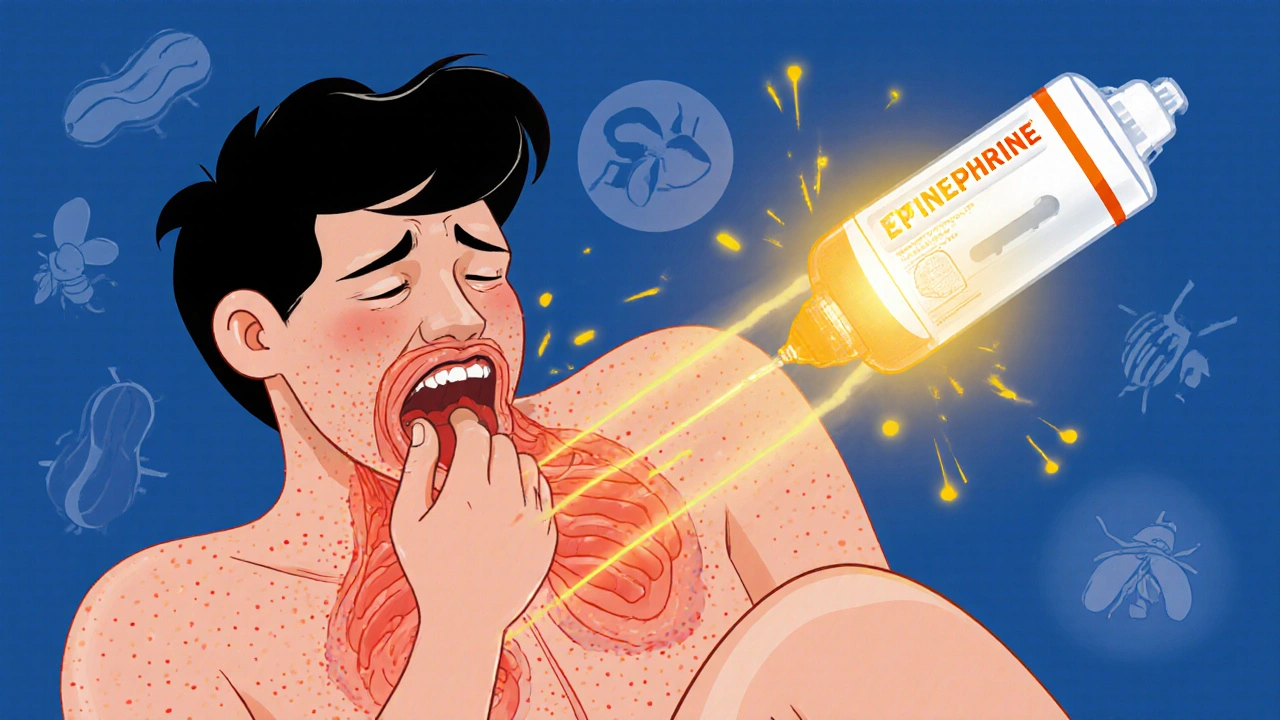When your body overreacts to something harmless-like a peanut, a bee sting, or a medication-it can trigger a life-threatening response called anaphylaxis. This isn’t just a bad rash or a stuffy nose. Anaphylaxis shuts down your airway, drops your blood pressure, and can kill you in minutes if not treated immediately. There’s one drug that saves lives in these moments: epinephrine. And if you or someone you care about has a serious allergy, knowing how and when to use it isn’t optional-it’s essential.
What Happens During an Anaphylactic Reaction?
Anaphylaxis doesn’t creep up. It hits fast. Within seconds to minutes after exposure to an allergen, your immune system goes into overdrive. Mast cells release chemicals like histamine, which cause blood vessels to leak, muscles in the airways to tighten, and your heart to struggle to pump effectively.
You might notice:
- Hives, swelling of the lips or tongue, or flushed skin (happens in 80-90% of cases)
- Wheezing, coughing, or trouble breathing (70% of cases)
- Dizziness, fainting, or a rapid, weak pulse (35% of cases)
- Nausea, vomiting, or abdominal cramps (45% of cases)
You don’t need all of these to be in danger. The key signs are problems with your airway, breathing, or circulation. Even if you only have hives and mild stomach upset after eating peanuts, if you’ve had a severe reaction before, this could be the start of something worse.
Why Epinephrine Is the Only Thing That Works
Antihistamines like Benadryl? They help with itching or hives-but they won’t stop your airway from closing. Steroids? They might reduce inflammation later, but they take hours to work. Neither saves your life in the moment.
Epinephrine is different. It’s the only treatment that reverses the dangerous changes happening in your body right now. It tightens blood vessels to raise your blood pressure, opens your airways so you can breathe, and helps your heart keep pumping. Studies show 97% of emergency doctors agree: if someone is having anaphylaxis, epinephrine is the first and only step that matters.
When given quickly-within minutes of symptoms starting-epinephrine improves symptoms in 85% of people within five minutes. Delay it by even 15 minutes, and your chances of dying go up dramatically. One study found that people who waited to use their epinephrine were five times more likely to end up in intensive care.
How to Use an Epinephrine Auto-Injector
Most people carry epinephrine in a simple device called an auto-injector. Brands like EpiPen, Auvi-Q, and Adrenaclick all work the same way: you remove the cap, press it firmly against the outer thigh, and hold it there for 3 seconds.
You don’t need to see a vein. You don’t need to inject into a muscle perfectly. The thick muscle on the outside of your thigh absorbs the drug quickly-faster than any other spot. Even through clothing, it works.
Here’s what to do:
- Recognize the symptoms-don’t wait for them to get worse.
- Remove the safety cap.
- Place the injector against the outer thigh (not the butt, not the arm).
- Push hard until you hear a click, and hold for 3 seconds.
- Call emergency services immediately-even if you feel better.
Why call 911 even after using it? Because anaphylaxis can come back. Up to 20% of people have a second wave of symptoms hours later. You need to be watched for at least 12 hours in a hospital if you’ve had a severe reaction.

What If You’re Afraid to Use It?
Many people don’t use their epinephrine because they’re scared. They think, “Maybe it’s not that bad.” Or, “I don’t want to give myself a shot.” Or, “I’ll wait and see.”
Here’s the truth: 43% of people delay using epinephrine until they’re already collapsing. That’s too late. The risk of using it when you’re not sure? You might get a racing heart or shaky hands for a few minutes. The risk of not using it? Death.
Practice with a trainer device-those plastic ones that don’t have a needle. Keep one at home, one in your bag, one in the car. Do a mock injection every month. Get your family, coworkers, or school staff to practice too. The more familiar you are with the device, the less panic you’ll feel when it matters.
Cost, Access, and Keeping Your Injector Ready
Epinephrine auto-injectors still cost a lot. In 2023, the average out-of-pocket price dropped to $185 for a two-pack-down from over $300 in 2016. But that’s still too high for many. Generic versions now make up 70% of prescriptions, and insurance often covers them. If you’re struggling to afford it, ask your pharmacist about patient assistance programs.
Check the expiration date every time you refill. Most last 12 to 18 months. Don’t store them in the car or the bathroom-they need to stay between 68°F and 77°F. If the liquid inside looks cloudy or has particles, replace it.
And don’t forget: if you’re a parent of a child with allergies, make sure their school has a stock epinephrine kit. All 50 U.S. states now require schools to keep them on hand. Teachers and nurses should know how to use them.

New Options and What’s Coming
In August 2023, the FDA approved Neffy-a nasal spray version of epinephrine. No needle. Just spray one puff into each nostril. It’s a game-changer for people terrified of injections, especially kids. It works almost as fast as the injection and is now available by prescription.
Future tech is also coming. Smart injectors with Bluetooth are being tested-they can alert your emergency contacts if you use them. Longer-lasting versions (good for 24+ months) are in trials. And for people with repeated severe reactions, a monthly injection called Xolair can reduce the need for epinephrine by two-thirds.
But none of these replace the need to act fast. Even with new tools, the rule stays the same: if you think it’s anaphylaxis, use epinephrine first. Always.
Common Mistakes and How to Avoid Them
People make the same errors over and over:
- Using antihistamines instead of epinephrine
- Injecting into the arm or buttocks instead of the thigh
- Waiting to see if symptoms get worse
- Not calling emergency services after use
- Not replacing expired devices
Only 37% of people who survive anaphylaxis get a written emergency plan from their doctor. That’s unacceptable. Ask for one. Write down your triggers, your symptoms, and exactly what to do. Keep it in your wallet. Give copies to your partner, your child’s teacher, your boss.
And if you’re ever unsure? Give the shot. It’s better to be safe than sorry.
Can anaphylaxis happen without hives or a rash?
Yes. While most people have skin symptoms like hives or swelling, about 10-20% of anaphylaxis cases don’t. If you have trouble breathing, feel dizzy, have a fast or weak pulse, or suddenly feel very sick after exposure to a known allergen, treat it as anaphylaxis-even if your skin looks normal.
Can you use someone else’s epinephrine auto-injector?
Yes, if it’s the right dose. An adult can use a child’s 0.15 mg injector in an emergency, and a child can use an adult’s 0.3 mg injector if no other option is available. The risk of under-treating anaphylaxis is far greater than the risk of giving too much epinephrine. It’s better to use the wrong dose than to use nothing at all.
Is epinephrine safe for people with heart conditions?
Yes. People with heart disease, high blood pressure, or arrhythmias are at higher risk of dying from anaphylaxis. Epinephrine is still the safest option because the danger of the allergic reaction far outweighs the temporary side effects of the drug. Emergency doctors give epinephrine to heart patients all the time during anaphylaxis. Not giving it is the real risk.
Do I need to carry two epinephrine auto-injectors?
Always. About 20% of people need a second dose because symptoms return or don’t improve after the first. You can’t predict who will need it. Carrying only one puts you at risk. Keep one with you at all times and another at work, school, or in your car.
What if I’m not sure whether it’s anaphylaxis?
If you’ve been diagnosed with a severe allergy and you’re exposed to your trigger, treat it as anaphylaxis. Don’t wait for multiple symptoms. Don’t wait to see if it gets worse. Use the epinephrine. You can always go to the hospital and find out it wasn’t serious-but if you wait and it is, you won’t get a second chance.
What to Do After Using Epinephrine
Even if you feel fine after the shot, you’re not out of danger. Anaphylaxis can rebound. That’s why you must go to the emergency room after using epinephrine. Stay there for at least 12 hours if you have asthma, heart disease, or needed more than one dose.
While you wait, lie down with your legs elevated. Don’t stand or walk around-your blood pressure could drop further. If you’re alone, call someone to stay with you. If you’re with someone, make sure they know how to give a second shot if needed.
After the event, schedule a follow-up with an allergist. They can help you identify triggers, adjust your treatment plan, and possibly recommend immunotherapy or preventive medications like Xolair.
Anaphylaxis doesn’t care if you’re busy, scared, or broke. It strikes fast. But with the right knowledge and a ready epinephrine injector, you can turn a deadly moment into a survivable one. Don’t wait for a crisis to learn what to do. Learn now. Practice now. Carry it now. Your life depends on it.



I’ve had two EpiPens expire in my bag. Never used them. Whoops. 😅